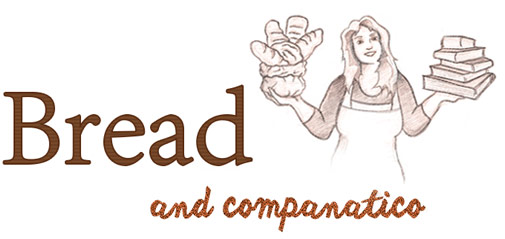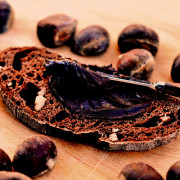EXTREME Country Sourdough For World Bread Day
I know, I have been evanescent from the blogsphere lately. I had so many nice dishes and breads, all nicely photographed and ready to be narrated, and yet could not resolve to write about them. Lack of time for sure but also something else… let’s call it writer’s block, if you allow a blogger to count as a writer of some sort. After all, two years have passed since I started blogging, and I guess a drop in motivation can happen after a while. So… you will have to wait until next summer for my figs with camembert, and hope to one day know about my expresso sourdough. Maybe, you will still be able to hear of my wild mushrooms risotto before the fall of the first snow (but they say they may snow any day now).
For sure, you are now going to hear about my latest loaf of bread. Yes indeed this bread was screaming to be told about and here I am, winning over my block and trying to find the words.
Have to admit that, while I like every sort of bread, I particularly appreciate a good country sourdough with an open crumb and a light and crunchy crust. However, getting entirely there, obtaining the crunchiness and lightness I sometimes appreciate in a basic country loaf, was not the easiest of tasks. I have long been giving the blame to my bad oven, which does not reach the (already pretty low) temperature of a standard oven. I have long given up the possibility to get good “ears” (that fancy detachment of the crust along the cuts that you can see in the first picture of this post) and left it to an indeterminate time in the future and to a better oven.
It comes out that the problem was in the method AND in the flours (two aspects which can win over a bad oven sometimes). Flours. Early after I started to bake bread I got hooked on local organic stone-ground flours. This is surely healthy. But… as I only recently found out, the protein content of the so-called “bread flour” I was using is 10.5%, pretty low for a bread flour (which by definition should have high protein content). Moreover, using 100% stone-ground flour means having quite a lot of fat in your loaf, ok, good fat, but this is not the point here. The point is that fat can reduce optimal gluten development and make impossible to reach that lightness you may be after in your loaves. On top of this, for a year I have been influenced by Chad Robertson’s book Tartine, where is suggested NOT TO knead the dough but instead use a very long fermentation at warm temperature, making lots of folds. He also suggests to bake in a combo cooker (which I religiously managed to get from USA thanks to a friend’s help).
Again… yes, I made a lot of good loaves before and during my Tartine’s infatuation, but I never could get that extreme lightness I saw sometimes in extremely good country sourdoughs (like for instance those HE was baking). Recently, a professional baker, Adon Shifon, not as famous as Robertson (yet) but getting there thanks to his incredibly beautiful loaves and his clear intelligence of bread, gave me the idea of changing the way I was handling the dough. Differently from Robertson, he was indeed kneading his loaves for quite a long time. Just like our great grandmothers used to do, right? So, that was it. I kneaded my dough, used stronger flours and not all stone-ground. I left behind my combo cooker, because I felt it was affecting my crumb. And… I also shortened fermentation times when not using the fridge (according to Robertson you need 8 hours of total fermentation at a pretty high temperature, to me this almost always resulted in overproofed loaves and I could – and still can – only do a long fermentation if going for a cold one – i.e. in the fridge). Anyway, the story says… I finally got the loaf I have been after for a while, and I was so happy about it that when it finally came out of the oven I kept going back and forth from the kitchen for a hour, just to look at it… how crazy is that?
EXTREME Country Sourdough
Ingredients for two large loaves: 428 g active sourdough starter with 120% hydration made using organic stone-ground bread flour (protein: 10.5%), 700 g bread flour (protein: 12%), 150 g organic stone-ground all-purpose flour (protein: 8.5%), 100 g organic whole-grain spelt flour (mine was from sprouted spelt; protein: 13%), 640 g water + 50 to be added when you put salt + 100 to add when you make the folds (but look at your dough before you add it); 20 grams of sea salt. In total hydration was 85%.
Method: Mix all the ingredients except the salt and the extra water. Knead for a few minutes. Let stand, covered for a while ( between 1/2 and 1 hour). Add the salt dissolved in 50 g of water and knead till you see that the dough becomes elastic. Let rise at room temperature (mine was 21-22 degrees Celsius/ca 70 degrees Fahrenheit) in a capable container, tightly closed, and make 2 folds at intervals of 40 minutes. From the moment I mixed the ingredients a total of 3 hours and 1/2 passed before I formed the loaves. Let rise for another couple of hours, covered. Bake in a preheated oven at 250 degrees Celsius/480 degrees Fahrenheit, with baking stone and initial steam. I baked it in the first 10-15 minutes at high heat, then gradually lowered the temperature and baked until the loaf felt lighter when lifted. Good luck!
Ingredienti per 2 pagnotte: 428 g lievito naturale al 120% d’idratazione (120 g di acqua per ogni 100 g di farina) fatto usando farina di tipo 2 macinata a pietra; 700 g di farina tipo 2; 150 g farina tipo 1 macinata a pietra; 100 grammi di farina integrale di farro macinata a pietra (la mia era ottenuta da farro germinato); 640 g acqua + 50 da aggiungere quando si mette il sale + 100 in piu’ da aggiungere quando si fanno le pieghe (ma guarda il tuo impasto prima di aggiungerla!); 20 grammi di sale marino. In totale l’idratazione era all’85% (85 g di acqua per ogni 100 g di farina).
Metodo: miscelare tutti gli ingredienti tranne il sale e i 50 g di acqua extra. Impastare per qualche minuto. Lasciar riposare, coperto per un po’ (tra 1/2 e 1 ora). Aggiungere il sale dissolto nei 50 g di acqua e impastare finche’ vedete che l’impasto e’ diventato elastico. Mettere a lievitare in un contenitore capace, ben chiuso e fare 2 pieghe a intervalli di 40 minuti. Dal momento che avete miscelato gli ingredienti, fate passare in tutto 3 ore o 3 e 1/2 massimo e poi formate i pani. Mettete a lievitare per un altro paio d’ore, coperto. Cuocete in forno preriscaldato a 250 gradi, con pietra refrattaria e vapore iniziale. Io cuocio a fuoco alto i primi 10-15 minuti, poi abbasso gradualmente e sforno quando sento che i pani sono leggeri. Per far venire le “orecchie”, io uso una lametta da rasoio e faccio un taglio quasi orizzontale al pane. In bocca al lupo!
With this loaf I participate to this year’s edition of:
World Bread Day, thank you Zorra!
Barbara Elisi
Latest posts by Barbara Elisi (see all)
- On Precision Scales, Dreams and Starting a Bakery - December 9, 2018
- Purple Sweet Potato Super-Soft Rolls - July 2, 2017
- IBS-Friendly Diet and Gluten-Free Gnocchi - June 24, 2017













